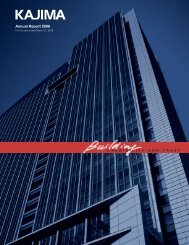full Annual Report 2003(5.9
full Annual Report 2003(5.9
full Annual Report 2003(5.9
Create successful ePaper yourself
Turn your PDF publications into a flip-book with our unique Google optimized e-Paper software.
Image of “Total Construction<br />
System of Shield Tunnels for<br />
Traffic Infrastructure”<br />
Image showing how Shiodome<br />
Media Tower’s hybrid airconditioning<br />
system works<br />
Air flow<br />
Fire prevention system for underground<br />
space — fire compartment<br />
using water screen system<br />
Total Construction System of Shield Tunnels for Traffic Infrastructure<br />
Growth in urban renewal and the passage of special legislation on public use of space deep underground<br />
have seen the increasing use of underground space for infrastructure, and plans that<br />
include the use of space deep underground for arterial roads in cities have made the cut and cover<br />
method difficult. It is in this context that Kajima has developed new technology that has made it<br />
possible to construct special sections of road tunnels (emergency parking bays, ramp tunnels) deep<br />
underground, and by integrating this with previously developed large-diameter shield tunnel technology,<br />
has developed a “Total Construction System of Shield Tunnels for Traffic Infrastructure.”<br />
This new technology comprises three methods: the “shield tunneling method of partly widening<br />
cross-sectional area,” the “shield tunneling method of reducing cross-sectional area” and the<br />
“shield tunneling method of applying recoverable and reusable machines.”<br />
Large-Scale Hybrid Air-Conditioning System with Natural Ventilation for Offices<br />
The heightened level of interest in environmentally-friendly buildings has resulted in stronger demand<br />
for natural ventilation. As well as developing specific design tools for the cost-efficient design of buildings<br />
using natural ventilation, Kajima has compiled a list of items for examination at the planning<br />
stage, including airflow simulation, assessment of the thermal environment, and a ventilation control<br />
strategy, which have led to the realization of large-scale hybrid air-conditioning systems with natural<br />
ventilation for offices. In the case of some buildings, we have commissioned natural ventilation<br />
systems and double-skin facades, and have confirmed their favorable performance.<br />
Fire Prevention System for Underground Space — Water Screen System<br />
As illustrated by the public use of space deep underground, the role of underground space in urban<br />
renewal is being re-evaluated. In doing so, however, fire safety requires serious attention.<br />
Experiments using scaled models have been repeated numerous times for railroad and vehicle tunnels,<br />
underground streets, and underground parking lots, resulting in the development of highly<br />
accurate simulation technology for simulating fire behavior in such spaces. Furthermore, knowledge<br />
gained through these activities has been used to develop and construct a fire prevention system in<br />
which compartments use water screens, a completely new concept. As well as localizing the size of<br />
the area affected by a fire and providing a safe evacuation environment, the system also inhibits<br />
rapid combustion, thus minimizing structural damage.<br />
Development of a Quantitative Assessment System for the Environmental Functions of<br />
Greenspaces — “m-EASE (microscale Environmental Assessment System on Ecology)”<br />
Kajima has developed a quantitative assessment system for the environmental functions of greenspaces<br />
called “m-EASE,” a green CAD system through which a quantitative assessment of the following<br />
six environmental functions of greenspaces can be made: fixation of atmospheric CO2;<br />
atmospheric purification; mitigation of heat island effects; preservation of biological diversities;<br />
improvement of scenery; and fire prevention. Use of this system has made it possible to promptly<br />
and effortlessly formulate proposals for optimum greenspace plans corresponding to customers’<br />
needs at the planning and design stages. The system also enables constructive “quantitative<br />
assessment of the environmental functions that greenspaces already possess” and “prediction of<br />
future changes of the functions of greenspaces.”<br />
Environmental Jet Method<br />
The environmental jet method is a ground contamination cleaning technique that is able to partially<br />
clean contaminated ground (soil and ground water) using intersecting jet flows of water. This<br />
method has the following advantages: (1) it is possible to partially clean at only the depths required;<br />
(2) it can be applied to various kinds of contaminated substances; (3) it can even be applied to contaminated<br />
layers difficult to penetrate with water (clay, etc); and (4) it can be applied in small places<br />
and even inside buildings.<br />
Kajima offers the following three options, depending on the contamination circumstances and<br />
budget for the cleaning work.<br />
1) The Jet Replace method for substituting contaminated soil with non-harmful materials.<br />
2) The Jet Blend method for cleaning ground water by mixing cleaning materials in contaminated<br />
water layers.<br />
3) The Jet Rinse method for cleaning contaminated soil.<br />
19






